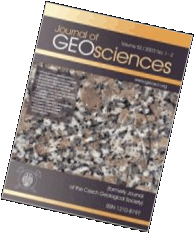 Export to Mendeley
Export to MendeleyOriginal Paper
The anatomy of an albite-type granitic pegmatite from the Totoral pegmatite field, San Luis, Argentina
Journal of Geosciences, volume 60 (2015), issue 1, 31 - 44
DOI: http://doi.org/10.3190/jgeosci.187
The Independencia Argentina albite-type granitic pegmatite is the most distal differentiate in the Cerro La Torre pegmatite group, located in the Eastern Pampean Ranges of Argentina. It is a zoned pegmatite formed at two main stages that probably shared the same origin but had separate evolutions.
The product of the first stage was a pegmatite dominated by albite, quartz and muscovite, with rare K-feldspar and muscovite + albite pseudomorphs after spodumene, and accessory columbite-group minerals, beryl, fluorapatite and garnet. This first-stage pegmatite was emplaced forcefully and crystallized syn-kinematically. Resulting boudinage and necking-down produced the main body, bulbous in shape and asymmetric in zoning.
This pegmatite was subsequently intruded by a melt that solidified to a very fine-grained, saccharoidal albite unit, composed in excess of 97 % by Ab99.1-99.6, with accessory columbite-group minerals and fluorapatite. The normative mineral composition of this unit corresponds very well with that of the experimental products of protracted fractionation of rare-element pegmatite melts, with high Na/K ratios and HFSE enrichment. The spatial and temporal association of the two pegmatitic melts, one enriched in H2O and the other one more evolved, Na-rich, almost alkaline and flux-bearing, strongly suggests that the two are cogenetic. They probably represent products of a rare-element pegmatite magma differentiation at depth that were extracted at different stages of its crystallization and emplaced at higher crustal levels.
Webdesign inspired by aTeo. Hosted at the server of the Institute of Petrology and Structural Geology, Charles University, Prague.
ISSN: 1803-1943 (online), 1802-6222 (print)
email: jgeosci(at)jgeosci.org


IF (WoS, 2023): 1.1
5 YEAR IF (WoS, 2023): 1.5
Policy: Open Access
ISSN: 1802-6222
E-ISSN: 1803-1943